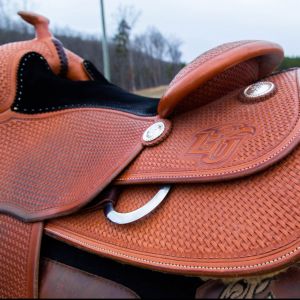Western vs English Riding
June 17, 2020
Written by Kimberly Counts, Assistant Coach/ Barn Staff
There are so many different activities and things you can do when it comes to riding a horse. Here at Liberty, the two disciplines we focus on are Western and English riding. Let’s take a closer look at the differences between the disciplines and find out what riding event you might like best!
Equipment
The most obvious distinction between English and Western riding is what the horse has on. When looking at the two saddles side by side, the most notable difference is the big horn on the front of the Western saddle. While many people think it’s an area to grab on to if they’re scared or nervous, there’s actually a very functional reason it’s there: ranchers use the horn as something to tie their ropes to, whether it be to pull or secure something. Western saddles are a lot heavier than English saddles and if you’re like me, it can sometimes be a struggle to heave the saddle up onto the taller horses’ backs!
An English saddle is smaller, more compact and not as flashy as a Western saddle. LU has saddles that are what we call forward seat, or close contact saddles. This type of tack is designed to keep the rider close to the horse and allows them to feel a lot of the horse’s movement underneath of them. These saddles are designed so that a rider can stand up off of a horse’s back when they’re clearing jumps. Now that you’ve learned about the saddles, let’s move on to disciplines!
Disciplines
Both Western and English riding have many different events that riders typically specialize in. Within the Western discipline, some of the more well-known events are reining and barrel racing. For English riding, some popular events are show jumping, hunter jumpers and equitation.
Have you ever seen a horse do a sliding stop, or spin really fast in a circle? This takes place in reining and is really fun to watch! Reining riders must memorize a pattern of intricate maneuvers and perform them to the best of their ability. These moves include things like sliding stops, guiding the horse through a variety of speeds, backing up long distances, and doing 180 degree turns. Reining takes a lot of precision and accuracy, and riders in the show ring are penalized pretty heavily if they mess up.
Barrel racing is a sport that you might be familiar with. Here, riders must go around a pattern of barrels, without knocking any down. The fastest rider, without penalties, wins. The name of the game is to be quick and efficient. If you knock a barrel over, or go off pattern, you’ll be penalized and possibly even disqualified. This sport is thrilling to watch and is very popular with riders who have a need for speed!
Another area of focus for riders lies in the English world of horseback riding. Here there are speed events (show jumping), classes judged on the horse (hunter jumpers), and classes judged on the rider (equitation). Each of these events is a little different, but they all fall back on the same foundations of riding.
Show jumping is similar to barrel racing, in that it’s a timed event, and there are penalties if the horse and rider make a mistake. Time faults, jumps knocked over, and horses refusing to jump are all penalties that cost the rider. In the end, it’s the fastest horse and rider combination with the least number of faults who win. This exhilarating event is fun to watch, especially as the jumps get higher and higher—sometimes the jumps are well over 5 feet!
Hunter jumpers and equitation are the last two English disciplines I’ll talk about. In the hunter ring, the horse’s way of going is what the judge is watching. In equitation, it’s the rider’s overall form on top of his or her horse. For both classes, riders must maneuver their horse around a course of at least 8 obstacles and judges are looking for what horse and rider combo can lay down the most effortless ride. It’s not easy to lay down a flawless round, but that’s the goal for hunter jumpers and equitation riders.
What’s Next?
Now that you’ve learned a little more about horses, come check out what the Equestrian Center has to offer. We’d love to show you around, schedule a lesson, and answer any questions you might have!

